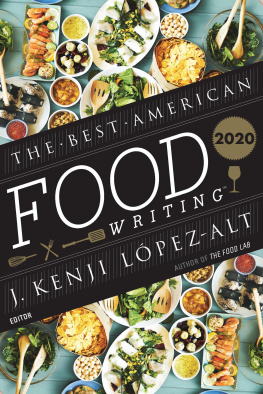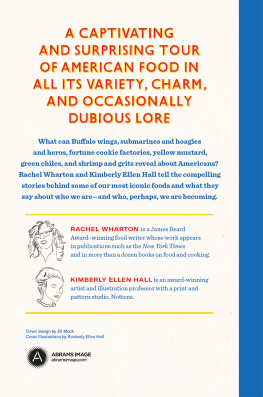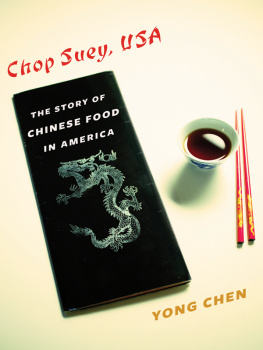MARK MCWILLIAMS is an associate professor of English at the United States Naval Academy. The editor of the Oxford Symposium of Food and Cookery, his work has appeared in journals like Early American Literature and Food, Culture, and Society. His Food and the Novel in America is forthcoming from the AltaMira Studies in Food and Gastronomy. He lives with his wife and two children in Severna Park, Maryland.
The Story Behind the Dish
CLASSIC AMERICAN FOODS
Mark McWilliams

Copyright 2012 by ABC-CLIO, LLC
All rights reserved. No part of this publication may be reproduced, stored in a retrieval system, or transmitted, in any form or by any means, electronic, mechanical, photocopying, recording, or otherwise, except for the inclusion of brief quotations in a review, without prior permission in writing from the publisher.
The publisher has done its best to make sure the instructions and/or recipes in this book are correct. However, users should apply judgment and experience when preparing recipes, especially parents and teachers working with young people. The publisher accepts no responsibility for the outcome of any recipe included in this volume and assumes no liability for, and is released by readers from, any injury or damage resulting from the strict adherence to, or deviation from, the directions and/or recipes herein. The publisher is not responsible for any readers specific health or allergy needs that may require medical supervision, nor for any adverse reactions to the recipes contained in this book. All yields are approximations.
Library of Congress Cataloging-in-Publication Data
McWilliams, Mark.
The story behind the dish : classic American foods / Mark McWilliams.
p. cm.
Includes index.
ISBN 978-0-313-38509-4 (hardback) ISBN 978-0-313-38510-0 (ebook) 1. Cooking, AmericanHistory. 2. Food habitsUnited StatesHistory. I. Title.
TX645.M39 2012
641.5973dc23 2011048298
ISBN: 978-0-313-38509-4
EISBN: 978-0-313-38510-0
16 15 14 13 12 1 2 3 4 5
This book is also available on the World Wide Web as an eBook.
Visit www.abc-clio.com for details.
Greenwood
An Imprint of ABC-CLIO, LLC
ABC-CLIO, LLC
130 Cremona Drive, P.O. Box 1911
Santa Barbara, California 93116-1911
This book is printed on acid-free paper 
Manufactured in the United States of America
Contents
Preface
Jean-Anthelme Brillat-Savarin, the great French philosopher in the kitchen who wrote, Tell me what you eat: I will tell you what you are, also claimed that The fate of nations depends on the way they eat. If he is right, the United States should have a pretty good future.
Brillat-Savarin published his famous aphorisms in 1825. Yet although his book was widely read, it took scholars many decades to consider food worthy of serious study. Until quite recently, histories and cultural studies rarely included food in their accounts. In retrospect, such omissions seem bizarre: what could be more central to daily life than food? And, as Brillat-Savarin well understood, what could be more indicative of individual, communal, and even national identity? Thankfully, those omissions are gradually being filled in. The rise of food studies has seen dramatic, interdisciplinary growth in the study of food.
In America, foodwaysthe useful term that includes all aspects of how a group produces, prepares, and consumes its foodhave changed as the nation has changed. At times, too, foodways have arguably changed the nation. The story of American food is as rich, as complicated, as contradictory as the story of America itself. That fact should not be surprising, since the two stories are so inextricably tied together.
This book tells specific parts of the continuing story of American food; the dishes represented here each contribute to the much larger tradition of food in America. American foodways are so varied and extensive, indeed, that any selection of dishes inevitably seems unrepresentative or incomplete. To select the dishes represented in this book, the editors and author worked to come up with a list of foods that either seemed inarguably American or represented some important development in American foodways. Some choices, in fact, include others: it is difficult to talk about hoagies, for example, without talking about subs, to discuss cobblers without Bettys or crisps.
Some dishes have long histories, sometimes even reaching back into antiquity. Others are recent inventions. Dishes seem to be established in America in three basic ways. The most common is the adaptation and adoption of foods from other parts of the world. The way immigrant groups struggle to retain their food traditions in a new land is almost a commonplace, whether one is discussing Irish Americans, Italian Americans, Cuban Americans, or any other group. Less often discussed is the way that was true of the English as well, who clung to the foodways of their own native land in what was, to them, the wilderness of the New World. Just as tenacious were the Africans brought here against their will: the ingredients and methods they smuggled alongside their enslaved bodies became one of the strongest influences on American foodways. Most American disheslike most American peoplehave roots elsewhere.
Other dishes are created by accident. A cook substitutes an unlikely ingredient, tries a different technique, or just makes some mistake. The commonly accepted story of the potato chips creation fits here (although the truth may be slightly more complicated) as does the famous story of the first chocolate chip cookies.
Others are created by necessity. Unexpected guests arrive; a group of customers enters a restaurant after the food runs low. Struggling to feed the new arrivals, cooks look over the available ingredients, combine them however they can, and hope for the best. Perhaps the best example is the well-knownand apparently true!story of the creation of Buffalo wings.
This book tells those stories. Each entry can be read individually to explore the history of a dish and its connection to other dishes, other lands. Read together, though, the stories behind these dishes combine into the story of American food: a story about the early and continuing appetite of Americans not just for more food, but for better and more varied foods; about the amazing importance of technological innovation; about the perhaps surprising role of wars in creating demand for new foods; and most important, about the ceaseless contribution of immigrant groups to American foodways. Together the entries tell, too, of continuing tensions in American food: tensions between the comfortably familiar and the excitingly new, between endless abundance and thoughtful restraint, between refreshing simplicity and dazzling combinations, between grinding poverty and inconceivable wealth. The story of American food, after all, is also the story of America.
. Jean-Anthelme Brillat-Savarin, The Philosopher in the Kitchen, trans. Anne Drayton (New York: Penguin, 1970): 13.
Acknowledgments
Writers can feel achingly alone, but I am tremendously fortunate to be part of wonderfully supportive scholarly, academic, and family groups. My deepest debts for this work are owed to those who have preceded me in establishing food studies as an accepted discipline. In countless ways, this work would not be possible without theirs. I have recommended many of their works in the suggestions for further reading that follow each entry and in the general suggestions that conclude the volume. But I have also benefited from the personal support and encouragement of many individualstoo many to name hereat gatherings such as the conference of the Association for the Study of Food and Society and the Oxford Symposium of Food and Cookery. A more welcoming and nurturing group of scholars cannot be imagined.










